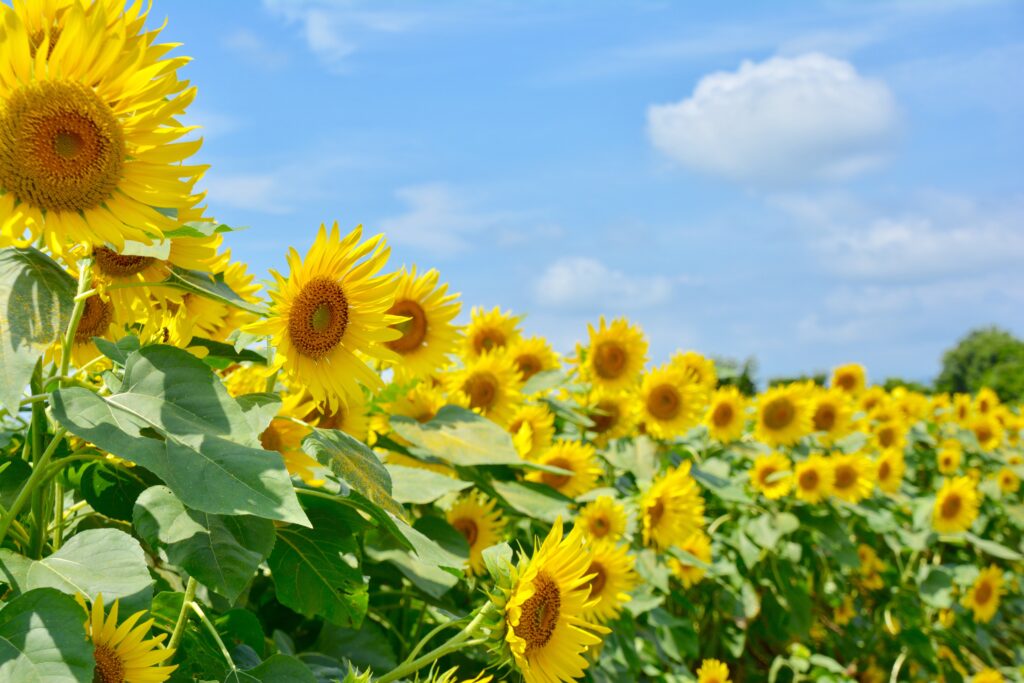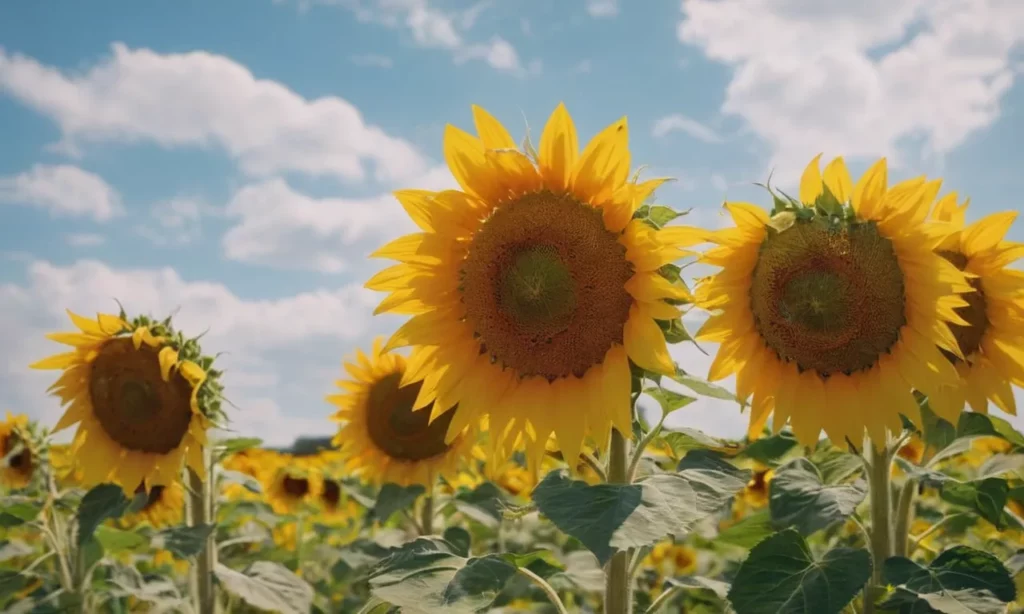19 Interesting Facts About Sunflowers

Sunflowers are one of the most recognizable flowers, known for their bright yellow petals and tall stalks that follow the sun. But there’s a lot more to these cheerful blooms than meets the eye. Here are 19 fascinating facts about sunflowers that reveal the history, uses, and biology behind this iconic flower.
1. Sunflowers belong to a large genus of flowering plants

The sunflower is a member of the genus Helianthus, which contains around 70 species of annual and perennial flowering plants. Most of the species are native to North America and Central America, with three species native to South America. The common sunflower (Helianthus annuus) is the most familiar and commercially important species that is cultivated worldwide.
2. Sunflowers originated in North America thousands of years ago
Sunflowers have an ancient history in North America. They were cultivated by indigenous peoples in the regions between Southern Canada and Mexico as far back as 3000 BCE. Sunflowers were an important crop used as a food source, for medicine, for dyes extracted from petals, and for oil from seeds. Sunflower seeds have even been found at some archeological sites dating to the Early Archaic period around 6000 BCE.
3. Sunflowers can grow quite tall
The sunflower is characterized in part by its tall stalk that can grow upwards of 10 feet tall. Most cultivated varieties grow to around 6 feet tall. However, giant sunflower varieties can reach towering heights of 12-15 feet tall! On the other end of the spectrum, miniature and dwarf sunflower varieties may only reach 1-3 feet in height.
4. Their flower heads contain thousands of small flowers

What appears to be a large, single flower is actually composed of hundreds or thousands of tiny flowers called florets clustered together in an inflorescence. The colorful ray florets around the perimeter make the yellow “petals.” At the center are the tubular disk florets which turn into seeds.
5. Sunflowers exhibit heliotropism
Sunflowers display a behavior called heliotropism, which means they turn their faces and follow the sun’s motion across the sky from east to west. Young sunflower heads track the sun’s daily journey, and as they mature over a few weeks, they permanently face east in anticipation of sunrise. This sun-following behavior optimizes sunflowers’ absorption of solar energy.
6. Facing east boosts pollination
Sunflowers that mature facing eastward can receive up to five times more pollinator visits compared to west-facing sunflower heads. Bees and other pollinating insects forage much more actively in the morning when the sun is rising in the east. So east-facing sunflowers expose their pollen and make it easily available to pollinators first thing in the morning.
7. The world’s tallest sunflower reached over 30 feet
In 2014, a sunflower in Germany’s Baden-Württemberg region was officially measured by Guinness World Records at 30 feet and 1 inch tall! This towering sunflower grown by Hans-Peter Schiffer overtook the previous record of 25 feet 5 inches held by a sunflower grown in Ontario, Canada.
8. Sunflowers have been used for medicinal purposes

Indigenous Americans as well as early European settlers utilized sunflowers for various medicinal purposes. Sunflower roots, leaves, and seeds were used to treat respiratory ailments. Extracts of sunflower heads were used for snake bites. Tea brewed from sunflower leaves has also been used to treat fever and lung problems.
9. Sunflower seeds have even been taken to space
Sunflower seeds have a surprisingly long history with space travel. In 1962, U.S. astronaut Scott Carpenter carried sunflower seeds aboard the Aurora 7 spacecraft which he later shared with his fellow Mercury astronauts to raise their spirits. In 2012, astronaut Don Pettit grew Helianthus annuus aboard the International Space Station to study growth in microgravity.
10. Sunflowers can be used as natural scrubbing pads
Once the seeds have been harvested, the dried sunflower head can serve as a 100% natural and biodegradable scrubbing pad. The sturdy and absorbent ray florets work well to scour greasy messes and tough stains. Using spent sunflower heads to clean helps reduce waste and cuts down on using paper towels.
11. Sunflowers come in colors besides just yellow
The iconic bright golden yellow sunflowers are by far the most familiar. However, sunflower varieties have been cultivated to produce blooms in shades of orange, burgundy, and maroon. Some rarer varieties sport fiery red petals. There are even mutants that produce all-white sunflowers.
12. Sunflowers range greatly in height

From miniature varieties that are only 18 inches tall to behemoths that soar over 15 feet, sunflowers come in a wide range of heights. Dwarf sunflowers are ideal for container planting while giant sunflowers make an eye-catching addition to the back of large beds and borders. Mid-height sunflowers around 6 feet tall are commonly grown in gardens and cut flower arrangements.
13. Sunflower seeds are highly nutritious
At the heart of every sunflower are its edible seeds, which are packed with important vitamins and minerals. Sunflower seeds contain high amounts of vitamin E, magnesium, selenium, phosphorus, B vitamins, iron, calcium, protein, and healthy fats. Sunflower seeds are also an excellent source of antioxidant polyphenols.
14. Sunflowers can help clean contaminated soil
Sunflowers have the ability to absorb toxins and pollutants from contaminated soil through their roots. This process is called phytoremediation. Sunflowers can take in toxic substances including toxic metals, fertilizer runoff, pesticides, and even radiation without perishing. Planting sunflowers can help clean industrial brownfield sites and land contaminated by leaks or spills.
15. Ukraine and Russia produce the most sunflowers
Ukraine and Russia account for over half of global sunflower cultivation and production. In 2017, Ukraine produced around 13 million metric tons of sunflowers, predominantly for oil production. Russia produced nearly 12 million metric tons. The world’s highest sunflower oil yields per hectare come from Spain.
16. Sunflowers have inspired art and culture
Sunflowers have been a frequent subject depicted in art, music, film, and literature. The bold blooms have been captured in works by artists like Vincent van Gogh and Georgia O’Keeffe. Songs like “Sunflower” by Post Malone and millions of social media posts prove the sunflower’s enduring cultural popularity.
17. There’s a peanut butter substitute made from sunflowers
For people with peanut allergies, sunflower seed butter is a tasty alternative to peanut butter. Also known as SunButter, this spread is made by roasting sunflower seeds, removing their shells, and grinding them into a smooth, peanut-like paste that can be used just like peanut butter. It contains vitamin E, magnesium, and fiber.
18. Breeding produced multi-branching sunflowers

While sunflowers typically have a single large bud on a single thick stem, breeders have created a mutation that causes side branches to form, each bearing its own flower head. These multi-branching sunflowers produce multiple blooms on every plant. Cutting the primary bud causes the axillary buds to grow and branch.
19. One sunflower can produce up to 200 seeds
A single sunflower seed quickly multiplies into hundreds more. A mature sunflower head can contain up to 2,000 raw seeds encased in inedible black-and-white striped shells. Once removed from the shells, the seeds can be eaten or pressed to extract their oil. Just 1 cup of sunflower seeds provides half the recommended daily vitamin E.
Conclusion
Sunflowers have brightened gardens, fields, and vases for thousands of years with their warm, radiant beauty. But they contribute much more than their sunny appearance. Their ecology supports pollinators and wildlife. Their biology reveals fascinating adaptations and a hearty nature. Their nutrients enrich diets and fuel healthy bodies. And their legacy in art and culture continues to inspire joy worldwide.
Sunflowers are more than just a pretty face – they are hardy, versatile, and captivating flowers that sustain life and uplift the spirit. As this journey through 19 sunflower facts shows, there are always new wonders to unfold about the spirited sunflower as it follows the dawn across the sky.





